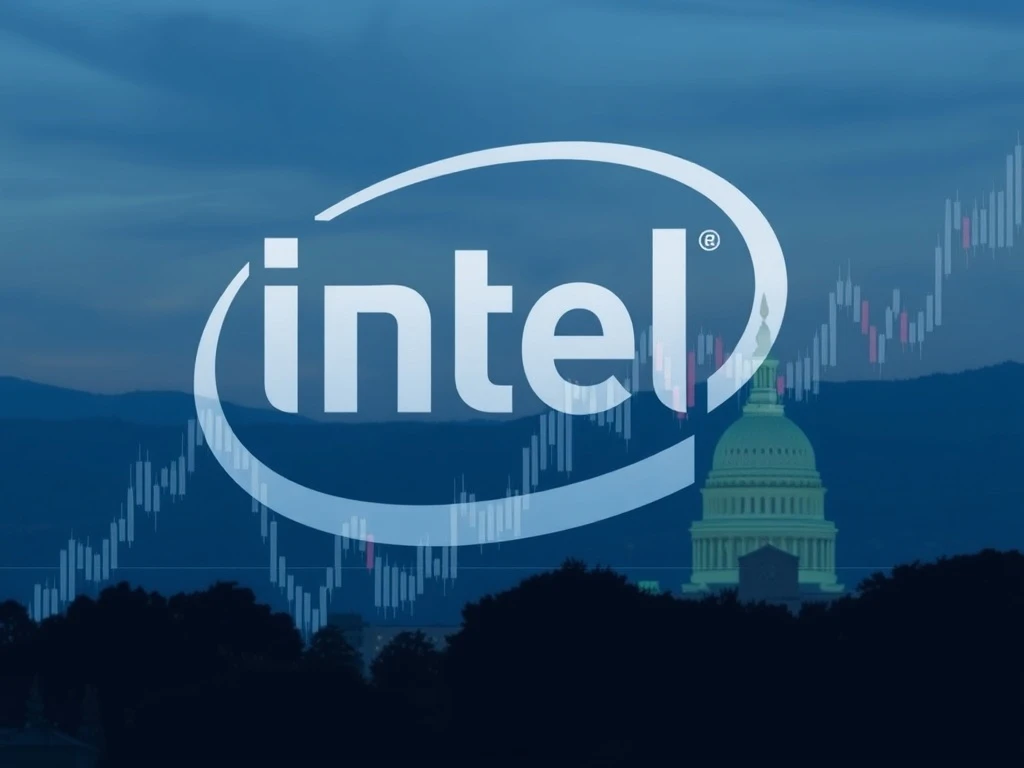The recent uplift in Intel stock has captured significant market attention. Investors and analysts are closely monitoring the company’s trajectory. This surge comes amidst a global focus on semiconductor independence and domestic manufacturing capabilities. Therefore, the question arises: will substantial government intervention further bolster Intel’s position and the broader U.S. chip industry? This article explores the factors driving Intel’s performance and the potential for unprecedented government assistance.
Understanding the Rise in Intel Stock
Intel, a foundational player in the semiconductor industry, has recently experienced a notable uptick in its share price. This positive movement reflects several underlying factors. For instance, strong earnings reports and strategic shifts often contribute to investor confidence. Additionally, the company’s renewed focus on advanced manufacturing processes and foundry services plays a crucial role. These initiatives aim to regain market share and enhance production capacity. Consequently, market participants are reacting positively to these developments.
The semiconductor sector itself is experiencing robust demand. Chips are essential components for countless modern technologies. They power everything from smartphones to artificial intelligence systems. Therefore, Intel’s performance is intrinsically linked to this expanding global need. Analysts suggest that increased demand for personal computers and data center infrastructure also supports Intel’s growth. This broad market demand creates a favorable environment for the company’s stock.
The Strategic Importance of Chip Manufacturing
Semiconductor manufacturing holds immense strategic importance for national economies and security. Chips are the backbone of modern technology. They enable critical infrastructure, defense systems, and economic competitiveness. During the COVID-19 pandemic, global supply chain disruptions highlighted vulnerabilities. These events underscored the urgent need for robust domestic chip production. Consequently, governments worldwide are prioritizing investment in this vital sector.
For the United States, fostering a strong domestic semiconductor industry is a key policy objective. Reliance on overseas manufacturing presents potential risks. These include supply disruptions and intellectual property concerns. Therefore, enhancing domestic capacity ensures a more secure and resilient technology ecosystem. This strategic imperative often leads to discussions about government support and incentives for companies like Intel. Such support can accelerate technological advancements and secure critical supply lines.
Government Aid: A Potential Catalyst for Intel Stock?
The prospect of significant government aid for the semiconductor industry is not new. However, recent discussions suggest a potentially unprecedented level of support. This assistance aims to revitalize domestic manufacturing and research. For example, the CHIPS and Science Act, enacted in 2022, allocates billions of dollars. These funds are designated for semiconductor manufacturing, research and development, and workforce development. Intel, with its extensive U.S. operations, stands to benefit substantially from these initiatives.
Such government programs can provide crucial financial incentives. These include grants, tax credits, and subsidies. They help offset the high costs associated with building and operating advanced chip fabrication plants. Furthermore, these funds can accelerate innovation and job creation. Industry leaders advocate for these measures. They argue that government support is essential to compete globally and ensure technological leadership. Therefore, the implementation of these policies could significantly impact Intel stock and its long-term growth trajectory.
Historical Precedents of Government Intervention
Government intervention in key industries is not without historical precedent. Throughout history, various nations have provided aid to strategic sectors. These have included aerospace, automotive, and energy. For instance, during economic downturns, governments often step in. They offer bailouts or stimulus packages to prevent widespread collapse. These actions aim to stabilize markets and protect jobs. In the tech sector, early research and development initiatives, often government-funded, laid the groundwork for many modern innovations.
However, the scale and scope of potential aid for semiconductors are particularly noteworthy. This level of support reflects a recognition of the industry’s foundational role. It also addresses the intense global competition. Previous administrations, including the Trump administration, also emphasized domestic manufacturing. This focus aimed to reduce reliance on foreign supply chains. Consequently, the current push for semiconductor aid builds on a bipartisan consensus regarding national economic security. This continuity signals a sustained commitment to the sector.
Market Implications and Investor Outlook for Intel Stock
The potential for substantial government aid carries significant implications for the market and Intel stock. Firstly, direct financial assistance can improve Intel’s balance sheet. It can also reduce the capital expenditure burden for new fabs. Secondly, policy support signals a commitment to the industry. This can boost investor confidence. It suggests a more stable and predictable operating environment. Consequently, this could attract more long-term investment into Intel and its peers.
However, investors also consider other factors. These include market competition and technological advancements. While government aid provides a tailwind, Intel must continue to innovate. It must also execute its strategic plans effectively. The company faces strong competition from rivals in various market segments. Therefore, sustained growth will depend on a combination of external support and internal performance. Market analysts will closely monitor how Intel leverages these potential funds for innovation and expansion.
Challenges and Considerations for Government-Backed Initiatives
While government aid offers significant advantages, it also presents challenges. One concern is the potential for market distortion. Subsidies can sometimes create an uneven playing field. They might favor certain companies over others. Another consideration involves the efficiency of fund allocation. Ensuring that funds are used effectively for long-term growth is crucial. Bureaucratic hurdles can also delay project implementation. These factors require careful management by both government agencies and recipient companies.
Furthermore, the global nature of the semiconductor industry means that domestic aid alone may not solve all issues. International cooperation remains vital for supply chain resilience. Critics also question whether government intervention stifles innovation. They argue that free market competition drives better outcomes. However, proponents assert that the strategic importance of semiconductors warrants unique intervention. Balancing these perspectives is key to successful policy implementation. Ultimately, the effectiveness of aid will depend on its design and execution.
The Future Landscape for Intel and the Semiconductor Industry
The future of Intel stock and the broader semiconductor industry appears poised for significant transformation. Government initiatives, coupled with Intel’s internal strategies, aim to reshape the landscape. Increased domestic manufacturing capacity could lead to more resilient supply chains. It could also foster a stronger U.S. technological base. This focus on onshore production is a long-term trend. It reflects a global shift towards greater national self-sufficiency in critical technologies.
Moreover, advancements in artificial intelligence, quantum computing, and other emerging fields will continue to drive demand for cutting-edge chips. Intel’s ability to innovate and deliver these next-generation products will be paramount. The interplay between market forces and government support will define the industry’s trajectory. Therefore, stakeholders will closely observe how these dynamics unfold. The ultimate goal is a robust, competitive, and secure semiconductor ecosystem for years to come.
In conclusion, the recent pop in Intel stock reflects both market optimism and strategic repositioning. The potential for unprecedented government help, particularly through initiatives like the CHIPS Act, could provide a significant boost. While challenges exist, the strategic importance of semiconductors makes robust support a compelling proposition. The coming years will reveal the full impact of these combined forces on Intel’s performance and the global chip industry.
Frequently Asked Questions (FAQs)
What factors are driving the recent rise in Intel stock?
The recent rise in Intel stock is primarily driven by several factors. These include strong quarterly earnings reports and a renewed focus on advanced manufacturing. Additionally, the company’s strategic shift towards foundry services and robust global demand for semiconductors contribute significantly. Investor confidence in Intel’s long-term strategy also plays a role.
How might government aid impact Intel’s manufacturing capabilities?
Government aid, such as funds from the CHIPS Act, can significantly boost Intel’s manufacturing capabilities. This aid can provide financial incentives for building new fabrication plants. It can also support research and development efforts. Furthermore, it helps offset high capital expenditures. This enables Intel to expand production capacity and develop next-generation technologies more rapidly.
What is the CHIPS and Science Act, and how does it relate to Intel?
The CHIPS and Science Act is a U.S. federal law enacted in 2022. It allocates over $52 billion for semiconductor manufacturing, research, and workforce development. Intel, with its substantial U.S. manufacturing presence and investment plans, is a primary candidate to receive significant funding from this act. This funding aims to strengthen the domestic semiconductor supply chain.
Are there any risks associated with government intervention in the semiconductor industry?
Yes, risks exist with government intervention. These include potential market distortions, where subsidies might favor certain companies. There are also concerns about the efficient allocation of funds and potential bureaucratic delays. Some critics also argue that government aid could reduce competitive pressures, potentially stifling innovation. Balancing these risks with strategic goals is crucial.
What is the long-term outlook for Intel stock given these developments?
The long-term outlook for Intel stock appears cautiously optimistic. Potential government aid offers a significant tailwind, supporting domestic expansion and innovation. However, Intel’s sustained success also depends on its ability to compete effectively. It must also continue to innovate against strong industry rivals. The global demand for chips remains robust, providing a strong market foundation for future growth.
Why is domestic chip manufacturing strategically important for the U.S.?
Domestic chip manufacturing is strategically important for the U.S. due to national security and economic competitiveness. It reduces reliance on foreign supply chains, which can be vulnerable to disruptions. It also ensures access to critical components for defense systems and essential infrastructure. Furthermore, it fosters job creation and maintains technological leadership in a vital global industry.
























